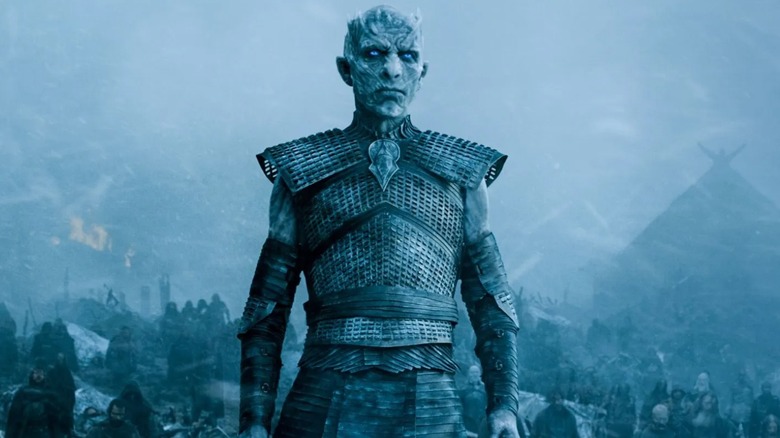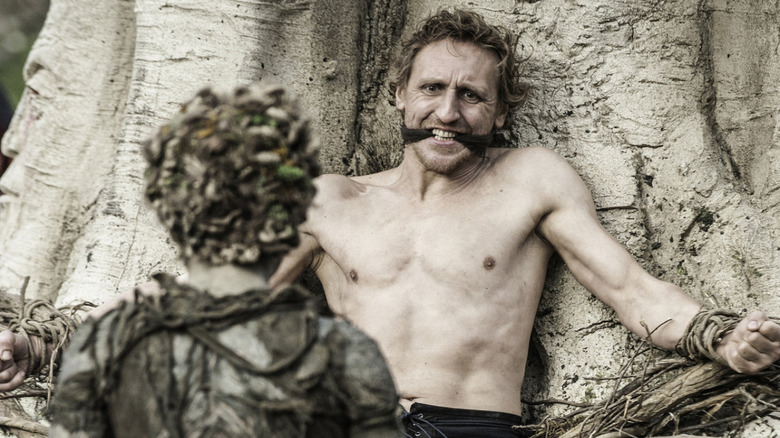Everything You Need To Know About The White Walkers From Game Of Thrones
In both "A Song of Ice and Fire," George R.R. Martin's series of fantasy novels, and "Game of Thrones," its HBO adaptation, readers and viewers meet the White Walkers, an undead army of frozen zombies who emerge from the far North to attack Westeros and its seven kingdoms. Seemingly unkillable and downright terrifying, the White Walkers, the eldest of whom are ancient beings that pre-date the Seven Kingdoms themselves, have some seriously scary skills. Not only are they all incredibly skilled in combat, wielding weapons that are likely as old as they are, but they can reanimate corpses and turn them into "wights," which are hard but not fully impossible to destroy and are basically homing missiles that destroy anything in their path. There are only a few definitive ways to defeat true White Walkers, and they're not exactly easily accessible: They have to be stabbed with either dragonglass or Valyrian steel, both of which are extremely rare in Westeros.
This all sounds pretty bad, right? If you somehow haven't seen "Game of Thrones" (or it's just been a while), the White Walkers are exactly as bad as they sound. So where did they come from? What happens to them throughout "Game of Thrones," and what prophecies in this universe focus on the arrival and eventual destruction of the White Walkers? Here's everything you need to know about the big bad villain in "Game of Thrones."
During an early war in Westeros, the Children of the Forest created the Night King
In a flashback on "Game of Thrones," we actually do learn how the first White Walker was created ... specifically, the White Walker who goes on to become the dreaded and seemingly infallible Night King. Thanks to Bran Stark's (Isaac Hempstead-Wright) bond with the Children of the Forest after becoming the Three-Eyed Raven, he watches a past scene where said Children, at war with the First Men before Westeros even truly becomes a continent, kidnap one of their enemies. After the Children stab him with tainted dragonglass while he's held against a sacred weirwood tree, the man becomes the undead Night King, meaning that the Children of the Forest created their own greatest enemy. (Appropriately, this mortal man is played by Vladimir Furdyk, who goes on to play the Night King himself after the role was originated in previous seasons by Richard Brake.)
Shocked by what they've done, the Children of the Forest are forced to team up with their previous opponents, the First Men, to beat back the undead group they simply refer to as the "Others" — especially the Night King, who loses his human soul and becomes hellbent on destroying all life (not just men, but the Children of the Forest who cursed him with this existence). After the two newly allied groups succeed in holding the Night King and his new undead forces back, the Wall and the Night's Watch come into being thanks to the First Men, keeping a strict separation between the far, far North that the White Walkers call home and the lands where men reside.
Aegon the Conqueror's prophecy predicted the return of the White Walkers
A new piece of information about the White Walkers comes courtesy of "House of the Dragon," the first spin-off of "Game of Thrones" that centers around a violent era of House Targaryen called the "Dance of the Dragons." After accepting that he must anoint his only heir Rhaenyra (Milly Alcock) as his successor (even though she's a girl), King Viserys I Targaryen (Paddy Considine) finally fills her in on a prophetic dream concerning White Walkers and their endless winter that their ancestor, Aegon the Conqueror, once had:
"Aegon foresaw the end of the world of men. It's to begin with a terrible winter, gusting out of the distant North. Aegon saw absolute darkness riding on those winds, and whatever dwells within will destroy the world of the living. When this great winter comes, Rhaenyra, all of Westeros must stand against it. And if the world of men is to survive, a Targaryen must be seated on the Iron Throne. A King or Queen, strong enough to unite the realm against the cold and the dark. Aegon called his dream 'The Song of Ice and Fire.'"
Aegon isn't the only person to predict the arrival of the White Walkers. "There will come a day after a long summer when the stars bleed and the cold breath of darkness falls heavy on the world. In this dread hour a warrior shall draw from the fire a burning sword," Melisandre says to Stannis Baratheon in the second novel, titled "A Clash of Kings." "And that sword shall be Lightbringer, the Red Sword of Heroes, and he who clasps it shall be Azor Ahai come again, and the darkness shall flee before him." So when do these icy zombies actually show up?
Throughout Game of Thrones, the White Walkers slowly draw closer to Westeros
In the very first scene of "Game of Thrones," we see a freakishly young White Walker as an unnamed man of the Night's Watch (the organization made up of bastards, criminals, and other generally unwanted men sworn to guard the Wall and protect Westeros from the evils that lie beyond it) find a ring of body parts with a young female White Walker in its center. The man is beheaded for fleeing, as nobody believes him; the man who beheads him happens to be the lord of Winterfell, Eddard "Ned" Stark (Sean Bean), our apparent protagonist at the beginning of both the books and the television series.
Unfortunately for Ned, who gets his own head chopped off by the end of season 1 of "Game of Thrones," that random guy was right. The White Walkers are making their way south towards Westeros to accomplish that whole "destroy all living creatures" thing the Night King envisioned, and thanks to new Night's Watch recruits Jon Snow (Kit Harington) and Samwell Tarley (John Bradley), we see quite a lot of them throughout the early seasons of "Game of Thrones." In fact, Sam is the first character in "Game of Thrones" to kill a White Walker onscreen when he meets one north of the Wall and is able to wield a dragonglass dagger effectively; Jon becomes the second in season 5 when he fights the Night King's army at Hardhome and wields a sword made from Valyrian steel. As highborn lords and ladies squabble over the Iron Throne, the men in the north are acutely aware that there's a larger threat looming ... and it all becomes quite apparent in season 7.
In season 7 of Game of Thrones, the White Walkers breach the Wall
It pains me to talk about this particular plotline from season 7 of "Game of Thrones," because it's a prime example of every person on the show developing a major case of the stupids (a phenomenon that, honestly, ruined the final two seasons of the show entirely for me). Still, here goes: Adamant that Queen Cersei Lannister (Lena Headey) and her main rival Daenerys Targaryen (Emilia Clarke) recognize the looming threat of the White Walkers, Jon Snow decides that a bunch of people, including him, should head to the far north, capture one (1) wight, and bring it back to Westeros to show the vengeful, angry queen and her vengeful, angry would-be successor that they need to band together and fight a larger force, putting their own issues aside for the greater good.
Wights pretty famously don't travel solo, so that's the first problem. Once Jon and his merry band of idiots get their hands on that single wight, they find themselves surrounded by others as well as the Night King, protected only by a spot on an ice floe that the wights and White Walkers apparently can't cross. After one of those idiots, Gendry (Joe Dempsie), fast-travels back to Dragonstone to tell Daenerys what happened, she shows up with all three of her dragons and saves Jon and his dumb buddies, only for the Night King to take down her smallest beast, Viserion, and turn him into a fire-breathing undead dragon. (If wights and White Walkers can't swim, I'm dying to know how they dragged the dead dragon up from its watery grave to reanimate it, but whatever.) An undead dragon is bad news as Daenerys, Jon, and their forces prepare for war against the White Walkers.
The final season of Game of Thrones sees the destruction of the White Walkers
"Game of Thrones" basically always had to end with a massive showdown between the White Walkers and a band of humans desperate to stop them at any cost, and that's precisely what happens in the eighth and final season of the HBO series. In the third episode of that final outing, simply titled "The Long Night," Jon, Daenerys, and their forces, including skilled knights like Jaime Lannister (Nikolaj Coster-Waldau) and Brienne of Tarth (Gwendoline Christie), trained fighters like Arya Stark (Maisie Williams), and even formidable wildlings like Tormund Giantsbane (Kristofer Hivju), prepare Winterfell for an attack by the Night King and his forces. Daenerys and Jon, meanwhile, get a nasty shock when they realize the Night King now has his own dragon thanks to that handy reanimated corpse of Viserion, which brings down part of the Wall itself in the season 7 finale.
While protecting the Night King's apparent target, Bran, the newly reformed Theon Greyjoy (Alfie Allen) dies alongside many other fighters, and all hope seems lost ... until Arya emerges with a Valyrian steel dagger in hand. Because the Night King is the de facto "father" of all wights and White Walkers thanks to his creation (and continuation of his race), when Arya kills him, all of his army dies also. Was this an unbelievably bombastic way to take down one of the big bads of "Game of Thrones" that was fun at the time? Yeah! Is it sort of annoying that this immovable force (the Night King and his massive army) is actually super movable when the narrative requires it? Yeah! In any case, that's the end of the White Walkers on "Game of Thrones," which is streaming on HBO Max now.





